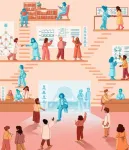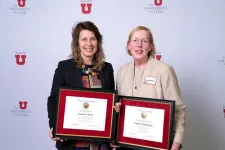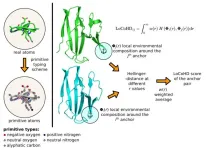(Press-News.org) New Curtin University research reveals taking pictures of food isn’t just content for our social media feeds, but could be the key to improving people’s diets.
Published in the prestigious American Journal of Clinical Nutrition, the feeding study saw researchers measure the weight of meals, which were then provided to participants over a day for breakfast, lunch and dinner.
Participants compared different technology-assisted methods to recall what they had eaten over the past 24 hours.
One method asked participants to take photos of their meals using the mobile Food Record app.
These photos were then analysed by a research dietitian.
The study found the accuracy of the nutritional intake was far higher for the group who had taken photos of what they ate, compared to participants who were asked to remember what they had eaten.
First author and PhD candidate Clare Whitton said this was the largest feeding study to use the mobile Food Record app and the findings could have a big impact on how we capture what the population is eating.
“Accurate, reliable data about what the population is eating is key to supporting people to optimise their health,” Ms Whitton said.
“People can struggle to remember what they have eaten, but this study shows dietary assessment can be accurate — particularly when you take the burden away from the person when you ask them to take a photo of what they ate.”
While the study saw the food photos analysed by experts, there is work underway to streamline the process.
The team is collaborating with Purdue University in the US to use artificial intelligence to automatically analyse the foods in the photos.
Study lead and mobile Food Record App co-creator Professor Deborah Kerr said this was an exciting development in getting the bigger picture of what people are eating.
“It makes it a lot simpler for people to track what they consume when they only have to take photos for the day,” Professor Kerr said.
“This will become even easier as we start to fully automate the analysis of the foods in the photos.
“With advances in AI technology this may be just around the corner.”
Professor Kerr said as technology advances, it could provide an avenue to not only better capture what populations are eating, but also offer more accurate dietary advice for individuals looking to eat healthier.
“This research shows the benefit of images; that's the pathway we're going down to get an accurate picture of what people are eating.”
‘Accuracy of energy and nutrient intake estimation versus observed intake using four technology-assisted dietary assessment methods: a randomized crossover feeding study’ was published in the American Journal of Clinical Nutrition.
END
Picture this: Snapping photos of our food could be good for us
New Curtin University research reveals taking pictures of food isn’t just content for our social media feeds, but could be the key to improving people’s diets.
2024-05-30
ELSE PRESS RELEASES FROM THIS DATE:
Portable pathology passes the test
2024-05-30
On-site pathology tests for infectious diseases in rural and remote locations can be just as reliable and accurate as tests carried out in a hospital laboratory, a new report from Flinders University shows.
Flinders University researchers tested the quality of on-site pathology testing, or Point-of-Care-Testing (POCT), for molecular-based, severe acute respiratory syndrome coronavirus 2 (SARS-CoV-2) detection in over 100 remote Aboriginal and Torres Strait Islander communities across Australia.
“Our study demonstrates that when point-of-care testing models are effectively established and managed, the quality of pathology results can be equivalent to ...
USC medical school dean appointed to CIRM board
2024-05-30
Carolyn C. Meltzer, MD, dean of the Keck School of Medicine of USC, has been appointed to the board overseeing the California Institute of Regenerative Medicine (CIRM). CIRM is the voter-created agency that funds stem cell research throughout the state.
“Stem cell research holds the tremendous promise to unlock health solutions that patients need,” said Steven D. Shapiro, MD, USC’s senior vice president for health affairs. “The CIRM board—and the people of our state—will benefit greatly from Meltzer’s wide-ranging leadership experience and place at the ...
Antibiotic pollution disrupts the gut microbiome and blocks memory in aquatic snails
2024-05-30
Antibiotics prevent snails from forming new memories by disrupting their gut microbiome - the community of beneficial bacteria found in their guts.
The new research, led by the University of East Anglia (UEA) in collaboration with Aberystwyth University, highlights the damaging effects that human pollution could be having on aquatic wildlife.
In the study, pond snails were given a favourite food – carrot juice – but had to quickly learn and remember that it was no longer safe to eat.
Snails ...
Researchers expose new symbiosis origin theories, identify experimental systems for plant life
2024-05-30
STARKVILLE, Miss.— A Mississippi State faculty member’s work on symbiosis—a mutually beneficial relationship between living organisms—is pushing back against the newer theory of a “single-origin” of root nodule symbiosis (RNS)—that all symbiosis between plant root nodules and nitrogen-fixing bacteria stems from one point—instead suggesting a “multiple-origin” theory of symbiosis which opens a better understanding for genetically engineering crops.
Ryan A. Folk, an assistant professor in the MSU Department of Biological Sciences and herbarium curator, is an author on a paper published this month in Nature ...
Q&A: How AI affects kids’ creativity
2024-05-30
Shortly after artificial intelligence models including Midjourney and OpenAI’s Dall-E went public, AI-generated art started winning competitions: one in digital art, another in photography. Concern rumbled that AI could replace artists — and even, by some metrics, be more creative than humans. But simultaneously, people were exploring these tools as ways to augment their creative processes, not replace them.
University of Washington researchers grew curious about how AI might affect creativity in children, specifically, so they worked with a group of 12 Seattle-area kids ages seven to 13 to explore how the kids’ creative processes interacted ...
Virtual lab meetings improve undergraduate research experience and foster diversity in academia
2024-05-30
Moisés A. Bernal, assistant professor in the Department of Biological Sciences at Auburn University, is collaborating with researchers Kathleen Lotterhos (Northeast University), Megan Phifer-Rixey (Drexel University), and Torrance Hanley, (Sacred Heart University) to evaluate the effectiveness of virtual lab meetings in demystifying the hidden curriculum in academia, incentivize primary research among students without previous experience, and foster participation of underrepresented groups in STEM.
The “Biological Practices” article entitled A virtual lab meeting training program mutually benefits mentees and host labs was recently published ...
Study shows effectiveness of updated COVID-19 vaccines wanes moderately over time, is lower against currently circulating variants
2024-05-30
May 29, 2024
Boosters that target the omicron subvariants of SARS-CoV-2 are still providing reasonably durable protection against infection, hospitalization and death from COVID-19, according to new data from a study led by researchers at the UNC Gillings School of Global Public Health.
Published today in the New England Journal of Medicine, the study found that COVID-19 boosters targeting the XBB.1.5 subvariants were most effective one month after receiving one. After four weeks, the vaccines were 52.2% effective at preventing infection and 66.8% effective at preventing hospitalization.
The vaccines were also highly effective ...
Researchers expose new ‘origin’ theories, identify experimental systems for plant life
2024-05-29
STARKVILLE, Miss.—A Mississippi State faculty member’s work on plant life symbiosis—a mutually beneficial relationship between living organisms—is pushing back against the newer theory of “single-origin”—that all life stems from one point—instead suggesting “multiple-origin” theory which opens a better understanding for genetically engineering crops.
Ryan A. Folk, an assistant professor in the MSU Department of Biological Sciences and herbarium curator, is an author on a paper published this month in ...
Researchers honored for outstanding contributions to cancer care
2024-05-29
Three Huntsman Cancer Institute researchers have recently been recognized for their work as outstanding faculty members at the University of Utah (the U).
Kim Kaphingst, ScD, director of cancer communication research at Huntsman Cancer Institute and professor of communication at the U, and June Round, PhD, investigator at Huntsman Cancer Institute and professor of microbiology and immunology at the U, were both granted the 2024 Distinguished Research Award. The faculty prize is given annually to scholars who exemplify exceptional research.
Kaphingst’s group explores cancer communication, particularly how to educate patients and families who ...
A new Hungarian method may aid protein research
2024-05-29
In a paper recently published in Nature Communications, the HUN-REN-ELTE Protein Modeling Research Group (Institute of Chemistry) has laid the foundations for a mathematical method, allowing the computer-assisted comparison of the three-dimensional structures of proteins. The method is unique in that while the alternatives available so far only took into account the position of the atoms, the new technique, called LoCoHD (Local Composition Hellinger Distance), also includes the chemical information of the atoms.
Proteins are molecular machines that carry out processes necessary for cells to function, acting as molecular switches, transcribing information ...
LAST 30 PRESS RELEASES:
Why nail-biting, procrastination and other self-sabotaging behaviors are rooted in survival instincts
Regional variations in mechanical properties of porcine leptomeninges
Artificial empathy in therapy and healthcare: advancements in interpersonal interaction technologies
Why some brains switch gears more efficiently than others
UVA’s Jundong Li wins ICDM’S 2025 Tao Li Award for data mining, machine learning
UVA’s low-power, high-performance computer power player Mircea Stan earns National Academy of Inventors fellowship
Not playing by the rules: USU researcher explores filamentous algae dynamics in rivers
Do our body clocks influence our risk of dementia?
Anthropologists offer new evidence of bipedalism in long-debated fossil discovery
Safer receipt paper from wood
Dosage-sensitive genes suggest no whole-genome duplications in ancestral angiosperm
First ancient human herpesvirus genomes document their deep history with humans
Why Some Bacteria Survive Antibiotics and How to Stop Them - New study reveals that bacteria can survive antibiotic treatment through two fundamentally different “shutdown modes”
UCLA study links scar healing to dangerous placenta condition
CHANGE-seq-BE finds off-target changes in the genome from base editors
The Journal of Nuclear Medicine Ahead-of-Print Tip Sheet: January 2, 2026
Delayed or absent first dose of measles, mumps, and rubella vaccination
Trends in US preterm birth rates by household income and race and ethnicity
Study identifies potential biomarker linked to progression and brain inflammation in multiple sclerosis
Many mothers in Norway do not show up for postnatal check-ups
Researchers want to find out why quick clay is so unstable
Superradiant spins show teamwork at the quantum scale
Cleveland Clinic Research links tumor bacteria to immunotherapy resistance in head and neck cancer
First Editorial of 2026: Resisting AI slop
Joint ground- and space-based observations reveal Saturn-mass rogue planet
Inheritable genetic variant offers protection against blood cancer risk and progression
Pigs settled Pacific islands alongside early human voyagers
A Coral reef’s daily pulse reshapes microbes in surrounding waters
EAST Tokamak experiments exceed plasma density limit, offering new approach to fusion ignition
Groundbreaking discovery reveals Africa’s oldest cremation pyre and complex ritual practices
[Press-News.org] Picture this: Snapping photos of our food could be good for usNew Curtin University research reveals taking pictures of food isn’t just content for our social media feeds, but could be the key to improving people’s diets.






